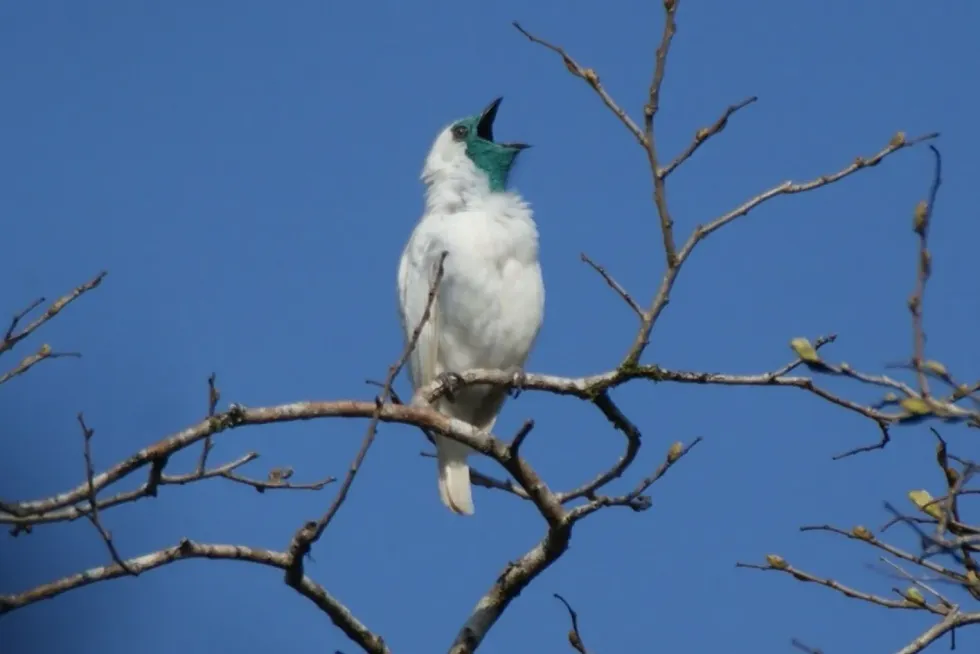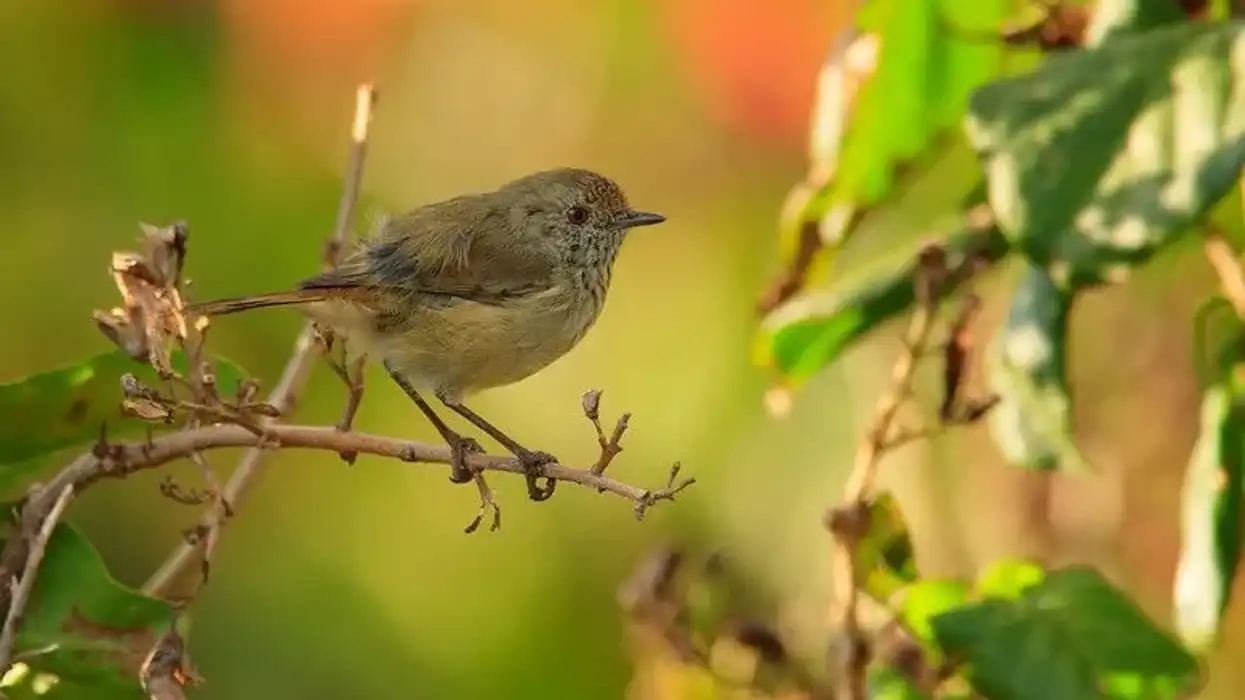The bare-throated bellbird is a species of Neotropical bellbird in the family of Cotingidae. Their population is threatened by poaching for the caged bird trade and a loss of habitat due to climate degradation.
This bird grabs the attraction of collectors thanks to the impressive coloration of adult males and their sharp, hammer-like call which only raises the attraction of these birds. From their perches on high branches of trees, males use this call to attract a mate.
The bare-throated bellbird (Procnias nudicollis) is a herbivorous, fruit-eating species of bird that feeds on fruits and seeds. As well as both sexes eating these seeds, they also act as seed dispersers in the ecology of the Atlantic rainforest.
This bird species can be found in places like Brazil, South Mexico, Argentina, and Paraguay. They are found in the Atlantic rainforest and among subtropical or tropical montane forests.
The bare-throated bellbird (Procnias nudicollis) is also the national bird of Paraguay! They are easy to spot from their perches on a high branch, due to their unique coloration which makes them stand out from other bird species.
These birds are peaceful and friendly, which is why they get along with humans. They are popular cage birds and are often kept as a pet.
Keep reading to learn all about these cage birds, or check out our Swainson's hawk and sooty tern facts too.
Bare Throated Bellbird Interesting Facts
What type of animal is a bare-throated bellbird?
The bare-throated bellbird (Procnias nudicollis) is a species of bird.
What class of animal does a bare-throated bellbird belong to?
The bare-throated bellbird (Procnias nudicollis) belongs to the Aves class of animals.
How many bare-throated bellbirds are there in the world?
The total number of bare-throated bellbirds present in the world is currently unknown.
Where does a bare-throated bellbird live?
A bare-throated bellbird (Procnias nudicollis) lives in subtropical or tropical moist forests. They are mostly seen in wet and moist places with good vegetation since they feed on fruits and seeds.
In subtropical or tropical moist forests, they are found in burrow-type nests, which the female, as well as the male bird, build together as a pair. Birds of this species build their nest during the breeding season to lay eggs and raise their offspring.
What is a bare-throated bellbird's habitat?
A typical bare-throated bellbird (Procnias nudicollis) habitat can be found in forests in southern Mexico, Argentina, Brazil, and Paraguay. They have also been spotted in the Atlantic rainforest, in urban settings, and parks. However, their main habitat usually consists of subtropical or tropical moist forests.
Who do bare-throated bellbirds live with?
The bare-throated bellbird (Procnias nudicollis) generally lives alone, but during the breeding season and when laying eggs, they stay in pairs and then form a family to take care of their chicks.
How long does a bare-throated bellbird live?
The lifespan of the bare-throated bellbird (Procnias nudicollis) is unknown.
How do they reproduce?
Males and females mate to reproduce, and the female lays eggs. Both the male and female, as a pair take care of their offspring.
The male often perches on a high branch to make a sharp sound to attract a mate. Females can lay up to two eggs per season, and incubation takes place for around 20 days.
Once the young birds hatch, they are fed by their parents until they are mature. Both sexes help to feed these birds, and the juveniles are mostly light or olive green in color, but their coloring becomes darker as they grow.
What is their conservation status?
The conservation status of the bare-throated bellbird (Procnias nudicollis) has been stated as Vulnerable, as their population is decreasing as a result of many reasons. An increase in the demand for the trade of cage birds and deforestation are just two of the main reasons.
Bare Throated Bellbird Fun Facts
What do bare-throated bellbirds look like?
The bare-throated bellbird (Procnias nudicollis) is a species of medium-sized birds and their coloration differs in small amounts. They are mostly light or olive green in color, and you can also sometimes see these birds in turquoise blue.
The female is attracted to the bright colors of the male. This bright coloring also raises the attraction to trade them as cage birds. Their feathers are bluish to green with a black head, but an olive-green coloration can be observed as well.
How cute are they?
These birds are very cute, considering their calm and friendly nature. Being bright green with a black head certainly makes these brightly colored birds stand out!
How do they communicate?
The bare-throated bellbird (Procnias nudicollis) species generally communicates through song, and this is mostly done by males when they make their breeding call. This call is a sharp sound like a hammer hitting metal!
How big is a bare-throated bellbird?
This bird family has a length that ranges between 10.6-11.4 in (27-29 cm), and they are 10 times bigger than a house sparrow, which is only 5.5-7 in (14-18 cm) in size.
How fast can a bare-throated bellbird fly?
The flying speed of this bird is unknown, but it is believed that it may be similar to the parrot bird species.
How much does a bare-throated bellbird weigh?
A bare-throated bellbird weighs between 5.75-7.94 oz (163-225 g).
What are the male and female names of the species?
No separate name has been used to describe a male or female bellbird. They have the same name for both sexes. Juveniles are also known by the same name, regardless of whether they are male or female.
What would you call a baby bare-throated bellbird?
The young birds of this species are usually known as chicks. Chicks and juveniles are most light in color when compared to their parents.
What do they eat?
The throated bellbird is a herbivorous bird. It is a fruit-eating species that mainly feeds on fruits, seeds, nuts, and plant-based food.
Are they dangerous?
These birds are not dangerous, instead, they are friendly and get along well with humans if given good care.
Would they make a good pet?
Bare-throated bellbirds are an ideal bird pet, they are almost as popular as the parrot! However, due to this popularity, illegal trading of cage birds has been seen in large numbers which has led to this bird species becoming a Vulnerable species.
As pets, they are cute and lovely and are also relatively easy to maintain since they eat predominantly fruits and seeds.
Did you know...
This bird species are known to have one of the loudest calls among other birds. Females have a lower tone than male birds of this species.
They are called bare-throated bellbirds since they do not have hair or feathers on their throat.
Bare-throated bellbirds are a monotypic bird species.
Bare-throated bellbirds are not migratory birds.
How to tell male and female bare-throated bellbirds apart?
Male birds have shiny white bodies with bare throats, whilst females are mostly olive green in color.
What type of calls do bare-throated bellbirds make?
They make calls that sound metallic; it is a sharp sound like a harsh hammer striking an anvil. Male birds make these sounds from a high branch to attract a female as well as to warn others against predators approaching.
Here at Kidadl, we have carefully created lots of interesting family-friendly animal facts for everyone to discover! Learn more about some other birds from our lanner falcon interesting facts and goliath heron facts for kids pages.
You can even occupy yourself at home by coloring in one of our free printable crested bellbird coloring pages.










